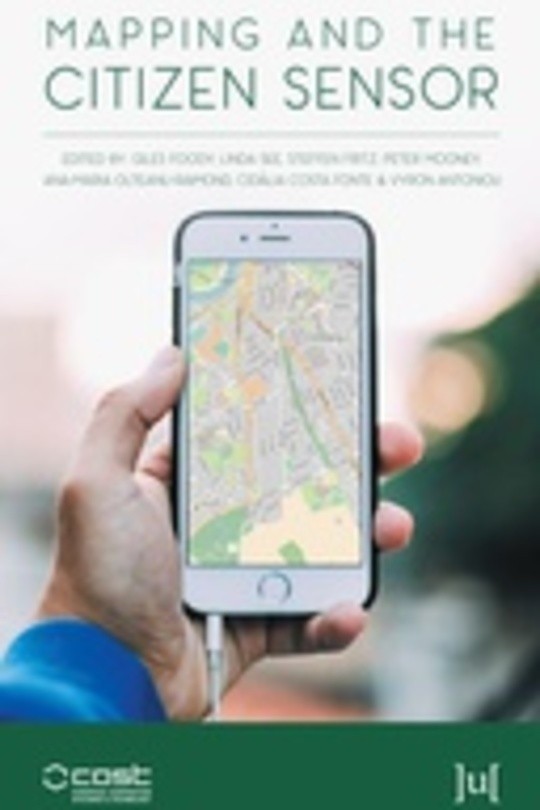
Mapping and the Citizen Sensor
Free
Description
Contents
Reviews
Language
English
ISBN
978-1-911529-16-3
Supporting Institutions
Chapter 1. Mapping and the Citizen Sensor
Giles Foody, Steffen Fritz, Cidália Costa Fonte, Lucy Bastin, Ana-Maria Olteanu-Raimond, Peter Mooney, Linda See, Vyron Antoniou, Hai-Ying Liu, Marco Minghini and Rumiana Vatseva
Chapter 2. Sources of VGI for Mapping
Linda See, Jacinto Estima, Andrea Pődör, Jamal Jokar Arsanjani, Juan-Carlos Laso Bayas and Rumiana Vatseva
Chapter 3. A Review of OpenStreetMap Data
Peter Mooney and Marco Minghini
Chapter 4. Production of Topographic Maps with VGI: Quality Management and Automation
Guillaume Touya, Vyron Antoniou, Sidonie Christophe, Andriani Skopeliti
Chapter 5. Motivating and Sustaining Participation in VGI
Steffen Fritz, Linda See and Maria Brovelli
Chapter 6. Considerations of Privacy, Ethics and Legal Issues in Volunteered Geographic Information
Peter Mooney, Ana-Maria Olteanu-Raimond, Guillaume Touya, Niels Juul, Seraphim Alvanides and Norman Kerle
Chapter 7. Assessing VGI Data Quality
Cidália Costa Fonte, Vyron Antoniou, Lucy Bastin, Jacinto Estima, Jamal Jokar Arsanjani, Juan-Carlos Laso Bayas, Linda See and Rumiana Vatseva
Chapter 8. The Impact of the Contribution Micro-environment on Data Quality: The Case of OSM
Vyron Antoniou and Andriani Skopeliti
Chapter 9. Visualisation and Communication of VGI Quality
Andriani Skopeliti, Vyron Antoniou and Temenoujka Bandrova
Chapter 10. The Relevance of Protocols for VGI Collection
Marco Minghini, Vyron Antoniou, Cidália Costa Fonte, Jacinto Estima, Ana-Maria Olteanu-Raimond, Linda See, Mari Laakso, Andriani Skopeliti, Peter Mooney, Jamal Jokar Arsanjani, Flavio Lupia
Chapter 11. Data and Metadata Management for Better VGI Reusability
Lucy Bastin, Sven Schade and Christian Schill
Chapter 12. Integrating Spatial Data Infrastructures (SDIs) with Volunteered Geographic Information (VGI) for creating a Global GIS platform
Demetris Demetriou, Michele Campagna, Ivana Racetin, Milan Konecny
Chapter 13. VGI in National Mapping Agencies: Experiences and Recommendations
Ana-Maria Olteanu-Raimond, Mari Laakso, Vyron Antoniou, Cidália Costa Fonte, Alexandra Fonseca, Magdalena Grus, Jenny Harding, Tobias Kellenberger, Marco Minghini, Andriani Skopeliti
Chapter 14. Opportunities for Volunteered Geographic Information Use in Spatial Planning
Matej Nikšič, Michele Campagna, Pierangelo Massa, Matteo Caglioni, Thomas Theis Nielsen
Chapter 15. Citizen Science and Citizens’ Observatories: Trends, Roles, Challenges and Development Needs for Science and Environmental Governance
Hai-Ying Liu, Sonja Grossberndt and Mike Kobernus
Chapter 16. The Future of VGI
Vyron Antoniou, Linda See, Giles Foody, Cidália Costa Fonte, Peter Mooney, Lucy Bastin, Steffen Fritz, Hai-Ying Liu, Ana-Maria Olteanu-Raimond and Rumiana Vatseva
The book hasn't received reviews yet.

